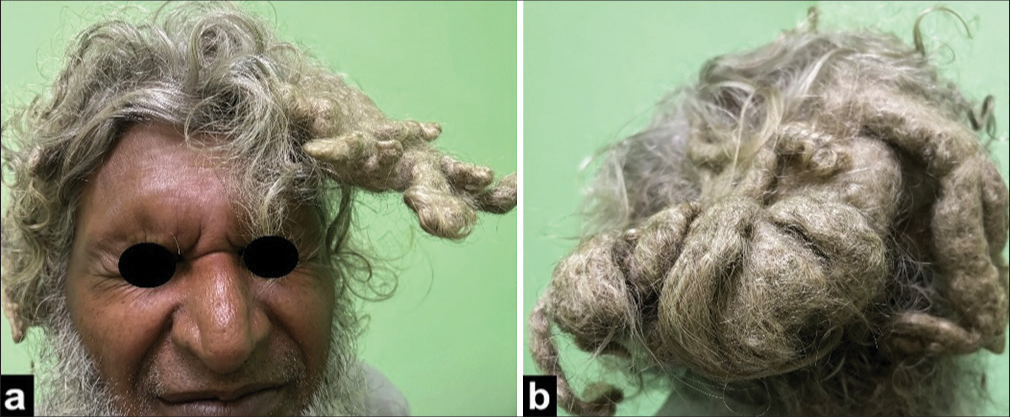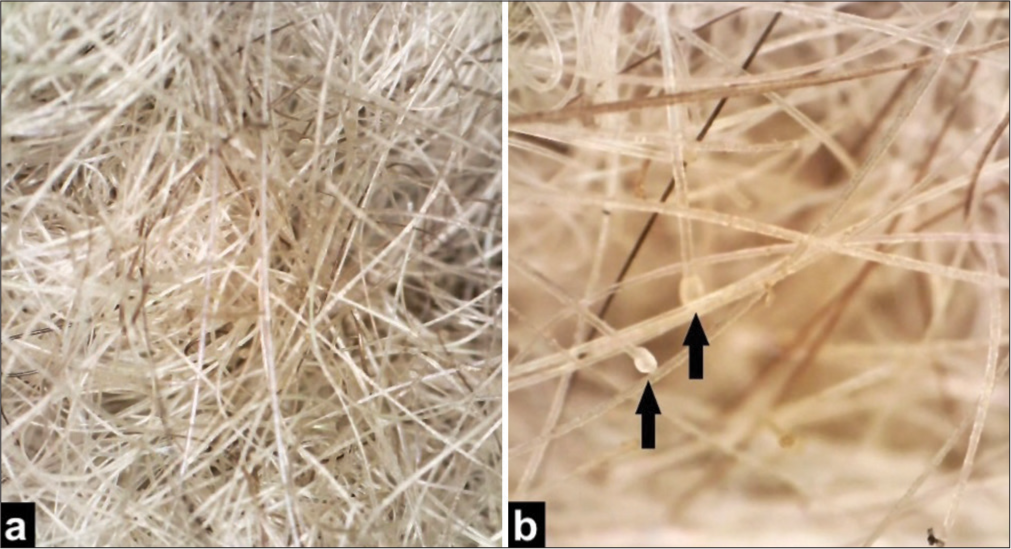Translate this page into:
Plica polonica – “tangled mesh of fiber optics” and “bulb pipette” dermoscopic appearance

*Corresponding author: Pradeep S. Nair, Department of Dermatology and Venereology, Government T D Medical College, Alappuzha, Kerala, India. dvmchtvm@yahoo.co.in
-
Received: ,
Accepted: ,
How to cite this article: Nair PS, Xson C, Kabilan T. Plica polonica – “tangled mesh of fiber optics” and “bulb pipette” dermoscopic appearance. CosmoDerma. 2024;4:129. doi: 10.25259/CSDM_145_2024
Dear Sir,
Plica polonica (PP), also known as plica neuropathica or “birds nest hair,” was described by Le Page in 1884 in women with hysterical tendencies.[1] A similar entity was then described in women of certain Polish communities; hence, it is also referred to as “Polish Plait” or ‘Vistula.” It has also been observed in our Rishis as a part of religious custom. PP is a psycho-cutaneous disorder where the patient does not wash the hair leading to matting and scaling of the hair with twisted and entangled hair fibers cemented together by keratin, dirt, and exudates, ultimately forming firm bundles that cannot be combed.[1,2] Alternately vigorous hair care using harsh shampoos and hair cleansers on a daily basis is also known to lead to PP.[3] Chemotherapy, pancytopenia leading to cuticular damage, and systemic retinoid therapy are other rare causes reported in the literature.[4] The classical dermoscopic appearance is a “wrangled mesh of wires” appearance. Light microscopy shows longitudinal splits in the hair shaft, twisted hair shafts, keratin debris, and scales.
A 72-year-old male presented to our outpatient clinic with complaints of uncombable and matting of hair of 5 years duration. Seven years ago, his only daughter died under tragic circumstances, and due to profound depression, he seldom bathed and never washed his hair, nor trimmed his hair. Consequently, he noticed that the hairs were matted together and could not be combed. He had no systemic comorbidities. On examination, there was gross matting and fusion of hair shafts with scaling forming a firm bundle at the frontotemporal region and occipital region [Figure 1a and b]. The rest of the scalp was normal, and there was no seborrhea. Dermoscopic examination showed white translucent hair fibers tangled together resembling a “tangled mesh of fiber optics” [Figure 2a] and some hairs had a bulbous end resembling a “bulb pipette” [Figure 2b]. We made a diagnosis of PP.

- (a) Bundle of entangled hair at the frontotemporal region and (b) occipital region.

- (a) Dermoscopy showing “tangled mesh of fiber optics,” Polarizing ×30, (b) “Bulb pipette” appearance (arrows), Polarizing ×80.
There is no specific treatment for PP. Proper care of the hair, cutting the matted hair, and scalp cleansers may help. The other reported treatment modalities are using organic solvents to separate the hair fibers, gentle oiling of the hair, frequent trimming of the hair, and psychiatric consultation when required.[3,4] In our patient, dermoscopic examination of the hair demonstrated white, translucent hair fibers resembling the fibers of fiber optics and some hair shafts had a bulbous end resembling a bulb pipette. Hence, we are reporting a new appearance – “tangled mesh of fiber optics” and “bulb pipette,” which has not been previously reported to the best of our knowledge.
Ethical approval
The Institutional Review Board approval is not required.
Declaration of patient consent
The authors certify that they have obtained all appropriate patient consent.
Conflicts of interest
There are no conflicts of interest.
Use of artificial intelligence (AI)-assisted technology for manuscript preparation
The authors confirm that there was no use of artificial intelligence (AI)-assisted technology for assisting in the writing or editing of the manuscript and no images were manipulated using AI.
Financial support and sponsorship
Nil.
References
- Plica neuropathica: Bird's nest under dermatoscope. Int J Trichol. 2022;14:109-11.
- [CrossRef] [Google Scholar]
- Plica neuropathica: Different etiologies in two cases. Indian J Dermatol Venereol Leprol. 2007;74:655-6.
- [CrossRef] [Google Scholar]





